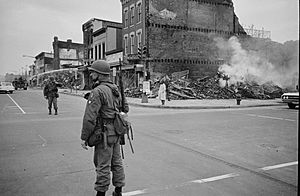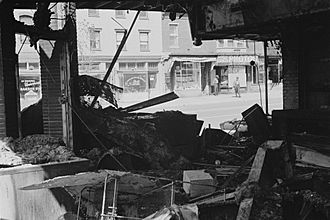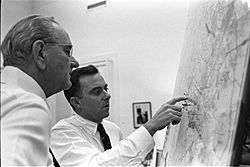King assassination riots facts for kids
Quick facts for kids King assassination riots |
|
|---|---|
| Part of the Ghetto riots | |

Soldiers stand near ruined buildings in Washington, D.C.
|
|
| Date | April 4 – May 27, 1968 |
| Location |
Over 100 cities across the United States
|
| Caused by | Assassination of Martin Luther King Jr., racial inequality |
| Methods | Rioting, looting, protesting, arson |
| Casualties | |
| Death(s) | 43 |
| Injuries | 3,000+ |
| Arrested | 20,000+ |
The King assassination riots, also known as the Holy Week Uprising, were a series of major protests and disturbances across the United States. These events happened after the terrible news that Martin Luther King Jr. had been assassinated on April 4, 1968. Many people believe this was the biggest wave of social unrest in the U.S. since the Civil War. Some of the largest riots took place in cities like Washington, D.C., Baltimore, Chicago, and Kansas City.
Contents
Understanding the Riots
Why the Riots Happened
The main reason for the riots was the assassination of Martin Luther King Jr.. King was a very important leader in the civil rights movement. He believed in peaceful protests and working within the government to make changes. His death made many people feel angry and hopeless. They felt that peaceful ways might no longer work against white supremacy (the idea that white people are superior). This led some to believe that only strong, even violent, actions could bring about change.
What Happened During the Riots
Most of the people protesting were Black, and they came from different backgrounds, not just poor ones. Middle-class Black people also protested against unfair treatment. Even though the news called these "race riots," there was little violence between Black and white people. Instead, people often targeted white-owned businesses. However, public buildings like schools and churches were usually left alone.
Compared to the big riots in 1967, fewer people died in 1968. This was partly because the government had new rules. They told police and soldiers not to shoot people who were just looting.
Events in Different Cities
In some cities, leaders worked hard to prevent major riots. In New York City, Mayor John Lindsay went to Harlem himself. He told Black residents he was sorry about King's death and was fighting poverty. This direct action helped stop bigger problems, though some small disturbances still happened. In Indianapolis, Indiana, Senator Robert F. Kennedy's speech is believed to have prevented a riot. In Boston, a James Brown concert on April 5 might have helped. James Brown, Mayor Kevin White, and City Councilor Tom Atkins spoke about peace before the show.
In Los Angeles, the police and community leaders worked to avoid a repeat of the Watts riots from 1965. Several events honored King in Los Angeles before his funeral.
Washington, D.C.
Washington, D.C., was one of the hardest-hit cities, along with Chicago and Baltimore. Many people had moved to Washington for government jobs. This helped middle-class Black neighborhoods grow. Even though segregation was illegal, areas like Shaw, H Street, and Columbia Heights were still centers of Black community life.
When news of King's murder spread on April 4, crowds gathered. Stokely Carmichael and others asked stores to close in respect. But soon, the crowd became angry and started breaking windows. By 11 PM, widespread looting began.
The next morning, Mayor-Commissioner Walter Washington ordered a cleanup. But anger was still high. Carmichael spoke at a rally, warning of violence. After the rally, crowds clashed with police. Many buildings were set on fire, and firefighters were attacked.
About 20,000 people overwhelmed the city's police force. President Lyndon B. Johnson sent in nearly 12,000 federal troops and 1,750 National Guard members. Marines put machine guns on the steps of the Capitol. Soldiers guarded the White House. At one point, the rioting got very close to the White House. This was the largest military occupation of an American city since the Civil War.
The mayor set a curfew and banned gun sales. By April 8, about 1,200 buildings had been burned, including over 900 stores. The damage cost about $27 million.
The riots badly hurt Washington's inner city. Businesses closed, jobs were lost, and insurance costs went up. People of all races moved to the suburbs, and property values dropped. Crime increased in the damaged areas. Some blocks remained in ruins for decades. Areas like Columbia Heights and U Street only started to recover when new subway stations opened much later.
Chicago
On April 5, the day after King was killed, violence started on the West Side of Chicago. It spread across a large area, especially in the North Lawndale and East Garfield Park neighborhoods. Rioters broke windows, looted stores, and set buildings on fire. Firefighters quickly arrived, and off-duty firefighters were called in. There were 36 major fires reported in just six hours.
The next day, Mayor Richard J. Daley set a curfew for anyone under 21. He closed streets to cars and stopped gun sales. About 10,500 police officers were sent out. Over 6,700 Illinois National Guard troops arrived, and President Johnson sent 5,000 regular Army soldiers. The general in charge banned gatherings in riot areas and allowed the use of tear gas. Mayor Daley even told police to "shoot to kill any arsonist" and "shoot to maim or cripple anyone looting."
By April 7, when order was restored, 11 people had died. About 500 were injured, and 2,150 were arrested. Over 200 buildings were damaged, costing about $10 million.
The South Side of Chicago avoided much of the chaos. This was partly because two large street gangs, the Blackstone Rangers and the East Side Disciples, worked to control their neighborhoods. Many gang members did not join the riots. This was because King had worked with these groups in 1966.
Baltimore
The Baltimore riot began two days after King's murder. On April 6, Maryland Governor Spiro Agnew called out thousands of National Guard troops and police. When they couldn't control the riot, Agnew asked President Johnson for federal troops. The riot was caused by King's assassination, but also by long-standing frustrations among Black residents.
By Sunday evening, 5,000 paratroopers and other soldiers arrived in Baltimore. They were trained in special tactics and carried bayonets and tear gas. Two days later, more soldiers joined them. With so many police and troops, the situation began to calm down. The FBI reported that H. Rap Brown was in Baltimore, encouraging protesters. The soldiers quickly stopped these disturbances using bayonets and tear gas. They arrested over 3,000 people, who were handed over to Baltimore police.
A curfew was set for 6 PM, and martial law was enforced. Black police officers and community leaders were sent to the worst areas to help stop the violence. By the end, 6 people had died, 700 were injured, and 5,800 were arrested. Property damage was over $12 million.
Governor Agnew gained attention for criticizing local Black leaders. He said they didn't do enough to stop the riot. This angered many, but it caught the eye of Richard Nixon, who was running for president. Nixon chose Agnew as his running mate in the 1968 election.
Kansas City
The riots in Kansas City started on April 9, not immediately after King's death. They began after local events in the city. The riot was sparked when Kansas City Police used tear gas on student protesters outside City Hall.
The tear gas scattered the students, but other citizens started rioting because of the police action. Over 100 adults were arrested. Six people died, and at least 20 were hospitalized.
New York City
Riots broke out in New York City the night King was murdered. Some violence and looting happened in Harlem, a large Black neighborhood in Manhattan. Tensions eased after Mayor John Lindsay visited the area. He expressed sorrow for King's death. However, many businesses in Harlem and Brooklyn were still looted and set on fire.
Pittsburgh
Disturbances in Pittsburgh began on April 5 and lasted until April 11. The worst day was April 7. About 3,600 National Guardsmen were sent into the city. Over 100 businesses were looted or burned in areas like the Hill District. Many buildings were set on fire. The riots left many Black business districts in ruins. These areas took a long time to recover.
Cincinnati
The Cincinnati riots were a response to Martin Luther King Jr.'s assassination. Tensions were already high in the Avondale neighborhood. This was due to a lack of job opportunities for Black men. King's death made these tensions much worse.
On April 8, about 1,500 Black people attended a memorial. An officer from the Congress of Racial Equality blamed white Americans for King's death. He urged the crowd to fight back. Rioters smashed store windows and stole goods. More than 70 fires were set, some very large. The next night, the city had a curfew. Nearly 1,500 National Guardsmen were brought in to stop the violence. After several days, two people had died, hundreds were arrested, and the city had $3 million in property damage.
Trenton, New Jersey
The Trenton Riots of 1968 were a major disturbance after King's assassination. More than 200 businesses in Downtown Trenton were looted and burned. Over 300 people, mostly young Black men, were arrested. They faced charges like assault, arson, and looting. Sixteen police officers were injured. Fifteen firefighters were also hurt while fighting fires or from attacks by rioters. People often pulled false fire alarms. Then, they would throw bricks at firefighters who responded. This led to fire departments stopping the use of open-cab fire engines.
The city estimated $7 million in losses, but insurance claims totaled $2.5 million. The Battle Monument neighborhood was hit hardest. This area had already seen many middle-class residents leave. The riots made things much worse for North Trenton. For decades, it remained one of the most troubled parts of the city.
Wilmington, Delaware
The riot in Wilmington was smaller than in other cities. It happened on April 9–10, 1968. But its aftermath was unique: a 9 and a half-month occupation by the National Guard. This showed how deep Wilmington's racial problems were. During the riot, the mayor asked for a small number of Guardsmen. But Democratic Governor Charles L. Terry sent in the entire state National Guard. He refused to remove them even after the rioting stopped. Republican Russell W. Peterson won the next election for governor. When he took office in January 1969, Governor Peterson ended the National Guard's occupation.
The occupation left lasting marks on Wilmington. Some people from the suburbs became afraid to go into the city. Over the next few years, businesses moved out. They took their employees, customers, and tax money with them.
Louisville
Riots also happened in Louisville, Kentucky, in May 1968. These were partly in response to King's assassination. On May 27, about 400 people, mostly Black, gathered in the Parkland neighborhood. This area was important for Louisville's Black community.
The crowd was protesting the possible return of a white officer. He had been suspended for beating a Black man weeks earlier. Community leaders told the crowd that no decision had been made. They hinted at future problems if the officer returned. The crowd started to break up.
However, false rumors spread that Stokely Carmichael's plane was being delayed by white people. People started throwing bottles, and the crowd became unruly. Police were called, but their small response only angered the crowd more. The police retreated, leaving a patrol car that was overturned and burned.
By midnight, rioters had looted stores and started fires. Mayor Kenneth A. Schmied asked for 700 Kentucky National Guard troops. He also set a citywide curfew. Violence continued the next day but calmed down by May 29. Businesses started to return, but troops stayed until June 4. Police made 472 arrests. Two Black teenagers died, and there was $200,000 in damage.
The riots had a lasting impact. Most white business owners left Parkland and nearby areas. Most white residents also left the West End. The riot created a negative image of Louisville's West End. It became seen as mostly Black and crime-ridden.
Local Issues and Responses
The assassination caused unrest in communities that were already struggling. For example, the Memphis sanitation strike was already happening. King had gone to Memphis to support these striking workers. He gave his last speech to them, and he was killed there. Negotiations on April 16 ended the strike and promised better wages.
In Oakland, there was growing tension between the Black Panthers and the police. This led to the death of Bobby Hutton.
Official Responses to the Riots
President Johnson's Actions
On April 4, President Lyndon B. Johnson spoke out against King's murder. He also started talking with mayors and governors. He wanted to prepare for how Black Americans might react. He warned against using too much force. But he felt local governments might not listen. He told his helpers, "I'm not getting through. They're all holing up like generals in a dugout getting ready to watch a war."
On April 5, Johnson met with many important leaders. These included Vice President Hubert Humphrey, Supreme Court Chief Justice Earl Warren, and civil rights leaders like Whitney Young and Roy Wilkins. Groups like SNCC and CORE, which were more radical, were not there. At the meeting, Mayor Washington asked President Johnson to send troops to Washington, D.C. Richard G. Hatcher, the new Black mayor of Gary, Indiana, spoke about white racism. He shared his fears of future violence. Many leaders told Johnson that new laws to help people would be the best way to respond. The meeting ended with prayers.
President Johnson was not surprised by the riots. His press secretary said Johnson felt, "When you put your foot on a man's neck and hold him down for three hundred years, and then you let him up, what's he going to do? He's going to knock your block off."
Military Help
After the Watts riots in 1965 and the Detroit riot of 1967, the military started preparing for possible unrest. So, when King was killed on April 4, the Pentagon quickly began its response. They ordered air force planes to get ready to go to Washington, D.C. The Army also sent undercover agents to gather information.
On April 5, Johnson ordered the Army and National Guard to be ready, especially for D.C.
President's Talks with City Leaders
Recordings show that Johnson's talks with local officials were often tense. In calls with Chicago Mayor Richard J. Daley, Johnson explained that he couldn't send federal troops until local governments had tried everything. Later, Johnson called the unrest a "war" at home. He criticized Daley for not asking for troops sooner. Johnson told Daley, "I'd rather move them and not need them than need them and not have them."
Impact of the Riots
Dozens of people died, and thousands were injured in the riots on April 4 and 5.
Physical Damage
Some areas were badly damaged and took a long time to recover. In Washington, D.C., poor city planning decisions made it even harder for areas to rebuild.
Political Changes
Dr. King had worked hard for a federal fair housing law since 1966. This law would stop discrimination in housing. But it had not passed. Senator Walter Mondale said that a fair housing bill was the most blocked law in U.S. history. Many senators from both the North and South were against it. Mondale said that earlier civil rights laws were about making the South behave. But this new law "came right to the neighborhoods across the country." It was about civil rights becoming "personal."
The riots quickly brought the bill back to life. On April 5, Johnson urged the United States House of Representatives to pass the Civil Rights Act of 1968. This act included the Fair Housing Act. The committee in charge, "shaken by the repeated civil disturbances," finally finished its hearings on April 8. With urgent attention from White House staff, the bill passed the House by a large vote on April 10.
Social Effects
For some liberals and civil rights supporters, the riots were a turning point. They made racial segregation and white flight (when white people move out of cities) even stronger. This created more racial barriers. The riots also gave the Republican party a way to gain support. They used fears of urban crime to push for "law and order" policies. This was especially true in the 1968 presidential campaign. The assassination and riots also made many people more radical. This helped the Black Power movement grow.
More to Explore
- Red Summer (1919)
- Long Hot Summer (1967)
- Post-civil rights era African-American history
- List of incidents of civil unrest in the United States



